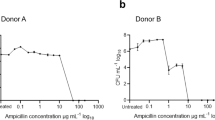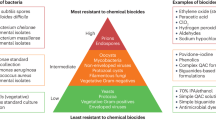Abstract
Considerable controversy surrounds the use of biocides in an ever increasing range of consumer products and the possibility that their indiscriminate use might reduce biocide effectiveness and alter susceptibilities towards antibiotics. These concerns have been based largely on the isolation of resistant mutants from in vitro monoculture experiments. To date, however the emergence of biocide-resistant strains in-vivo has not been reported and a number of environmental survey studies have failed to associate biocide use with antibiotic resistance. This article gives an overview of the issues as they currently stand and reviews data generated in our laboratory over the last five years where we have used laboratory microcosms of the environment and oral cavity to better understand the possible effects of real-life biocide exposure of these high risk ecosystems. In general, whilst biocide susceptibility changes can be demonstrated in pure culture, especially for E. coli towards triclosan, it has not been possible to reproduce these effects during chronic, sublethal dosing of complex communities. We conclude from this review that whilst the incorporation of antibacterial agents into a widening sphere of personal products may not overtly impact on the patterns of microbial susceptibility observed in the environment, the precautionary principle suggests that the use of biocides should be limited to applications where clear hygienic benefits can be demonstrated.
Similar content being viewed by others
References
Allison DG, McBain AJ & Gilbert P (2000) Microbial Biofilms: Problems of control. In: Allison DG, Gilbert P, Lappin-Scott H & Wilson M (Eds), Community Structure and Cooperation in Biofilms (pp 309–327). Cambridge University Press
Barnett M, Bushby SRM & Mitcheson DA (1953) Tubercle bacilli resistant to isoniazid:Virulence and response to treatment with isoniazid in guinea pigs and mice. British J. Exp. Pathol. 34: 568–581
Chapman JS (1998) Characterising bacterial resistance to preservatives and disinfectants. Int.Biodet.Biodeg. 41: 241–245
Chuanchuen R, Beinlich K, Hoang TT, Becher A, Karkhoff-Schweizer RR & Schweizer HP (2001) Cross-resistance between triclosan and antibiotics in Pseudomonas aeruginosa is mediated by multi-drug effux pumps: Exposure of a susceptible mutant strain to triclosan selects nfxB mutants overexpressing MexCD-OprJ. Antimicrob.Agents Chemother. 45: 432–482
Cole EC, Addison RM, Rubino JR, Leese KE, Dulaney PD, Newell MS, Wilkins J, Gaber DJ, Wineinger T, Criger DA (2003) Investigation of antibiotic and antibacterial agent cross-resistance in target bacteria from homes of antibacterial product users and nonusers. J. Appl. Microbiol. 95: 664–676.
Cookson BD, Farrelly H, Stapleton P, Garvey RPJ & Price MR (1991) Transferable resistance to triclosan in MRSA. British Med. J. 337: 1548–1549
Furia TE & Schenkel AG (1968) A new, broad spectrum bacteriostat. Soap Chem. Specialities 44: 47–50 and 116 –122
Gilbert P & McBain AJ (2003) An evaluation of the potential impact of the increased use of biocides within consumer products upon the prevalence of antibiotic resistance. Clin. Microbiol. Rev. 16: 189–208
Gillespie SH (2001) Antibiotic resistance in the absence of selective pressure. Int. J. Antimicrob. Agents 17: 171–176
Gjermo P & Eriksen HM (1974) Unchanged plaque inhibiting effect of chlorhexidine in human subjects after two years of continuous use. Arch.Oral.Biol. 19: 317–319
Heasman PA, Heasman L, Stacey F & McCracken GI (2001) Local delivery of chlorhexidine gluconate (PerioChip)in periodontal maintenance patients. J.Clin.Periodontol. 28: 90–95
Heath RI & Rock CO (1995) Enoyl-acyl carrier protein reductase (FabI)plays a determinant role in completing cycles of fatty-acid elongation in Escherichia coli. J.Biol. Chem. 270: 26538–26542
Heath RJ, Roland GE & Rock CO (2000) Inhibition of the Staphylococcus aureus NADPH-dependant enoyl-acyl carrier protein reductase by triclosan and hexachlorophene. J.Biol. Chem. 275: 4654–2659
Jones CL, Ritchie JA, Marsh PD & Van der Ouderaa F (1988) The effect of long-term use of a dentifrice containing zinc citrate and a non-ionic agent on the oral flora. J. Dent. Res. 67: 46–50
Lenski RE, Simpson SC & Nguyen TT (1994) Genetic analysis of a plasmid-encoded, host genotype-speci c enhancement of bacterial tness. J. Bacteriol. 176: 3140–3147
Levy SB (2000) Antibiotic and antiseptic resistance:Impact on public health. Pediatric Infect. Dis. J. 19: S120–S122
Levy CW, Roujeinikova A, Sedelnikova S, Baker PJ, Stuitje AR, Slabas AR, Rice DW & Rafferty JB (1999) Molecular basis of triclosan activity. Nature 398: 383–384
Lindhe J, Rosling B, Socransky SS & Volpe AR (1993) The effect of a triclosan-containing dentifrice on established plaque and gingivitis. J. Clin. Periodontol. 20: 327–334
Marsh PD (1992) Microbiological aspects of the chemical control of plaque and gingivitis. J. Dent. Res. 71: 1431–1438
McBain AJ & Gilbert P (2001) Biocide tolerance and the harbingers of doom. Int. Biodet. Biodeg. 47: 55–61
McBain AJ & Macfarlane GT (1998) Ecological and physiological studies on large intestinal bacteria in relation to production of hydrolytic and reductive enzymes involved in formation of genotoxic metabolites. J. Med. Microbiol. 47: 407–416
McBain AJ & Macfarlane GT (2001) Modulation of genotoxic enzyme activities by non-digestible oligosaccharide metabolism in in-vitro human gut bacterial ecosystems. J. Med. Microbiol. 50: 832–841
McBain AJ, Allison DG & Gilbert P (2000) Emerging strategies for the chemical treatment of microbial biofilms. Biotechnol. Genetic Eng. Rev. 17: 267–279
McBain AJ, Bartolo RG, Catrenich CE, Charbonneau D, Ledder RG & Gilbert P (2003a) Exposure of sink-drain microcosms to triclosan:Population dynamics and antimicrobial susceptibility. Appl. Environ. Microbiol. 69: 5433–5442
McBain AJ, Bartolo RG, Catrenich CE, Charbonneau D, Ledder RG, Rickard AH, Symmons SA & Gilbert P (2003b) Microbial characterization of bio lm in domestic drains and the establishment of stable biofilm microcosms. Appl. Environ. Microbiol. 69: 177–185
McBain AJ, Bartolo RG, Catrenich CE, Charbonneau D, Ledder RG & Gilbert P (2003c) Effects of triclosan-containing dentifrice upon the dynamics and antimicrobial susceptibility of in-vitro plaque ecosystems. Antimicrob. Agents Chemother. 47: 3531–3538
McBain AJ, Bartolo RG, Catrenich CE, Charbonneau D, Ledder RG & Gilbert P (2003d) Effects of chlorhexidine gluconate-containing mouthwash upon the vitality and antimicrobial susceptibility of in-vitro oral ecosystems. Appl. Environ. Microbiol. 69: 4770–4776
McDonnell G & Russell AD (1999) Antiseptics and disinfectants: Activity, action, and resistance. Clin. Microbiol. Rev. 12: 147–179
McMurry LM, Oethinger M & Levy SB (1998a) Triclosan targets lipid synthesis. Nature 394: 531–532
McMurry LM, Oethunger M & Levy SB (1998b) Over expression of MarA, SoxS, or AcrAB produces resistance to triclosan in laboratory and clinical strains of Escherichia coli. FEMS Microbiol. Lett. 166: 305–309
McMurry LM, McDermott PF & Levy SB (1999) Genetic evidence that InhA of Mycobacterium smegmatis is a target for triclosan. Antimicrob. Agents Chemother. 43: 711–713
Miesel L, Rozwarski DA, Sacchettini JC & Jacob WR (1998) Mechanisms for isoniazid action and resistance. Novartis foundation Symposium 217: 209–221
Regos J & Hitz HR (1974) Investigations on the mode of action of triclosan,a broad-spectrum antimicrobial agent. Zentral Blatt Für Bakteriologie und Hygiene Abteilung 1 Original A 226, 390–401
Reynolds MG (2000) Compensatory evolution in rifampinresistant Escherichia coli. Genetics 156: 1471–1581
Roujeinikova A, Sedelnikova S, deBoer GJ, Stuitje AR, Rafferty JB & Rice DW (1999) Inhibitor biding studies on enoyl reductase reveal changes related to substrate recognition. J. Biol. Chem. 274: 30811–30817
Russell AD (1997) Plasmids and bacterial resistance to biocides. J. Appl. Microbiol. 82: 155–165
Schrag S & Perrot V (1996) Reducing antibiotic resistance. Nature 382: 120–121
Suller MTE & Russell AD (1999) Antibiotic and biocide resistance in methicillin-resistant Staphylococcus aureus and vancymycin-resistant enterococcus. J. Hospital Infect. 43: 281–291
Walsh TF, Glenwright HD & Hull PS (1992) Clinical effects of pulsed oral irrigation with 0.2% chlorhexidine digluconate in patients with adult periodontitis. J.Clin.Periodontol. 19: 245–248
Author information
Authors and Affiliations
Rights and permissions
About this article
Cite this article
McBain, A., Gilbert, P. & Allison, D. Biofilms and Biocides: Are there Implications for Antibiotic Resistance?. Re/Views in Environmental Science and Bio/Technology 2, 141–146 (2003). https://doi.org/10.1023/B:RESB.0000040460.59517.5c
Issue Date:
DOI: https://doi.org/10.1023/B:RESB.0000040460.59517.5c




